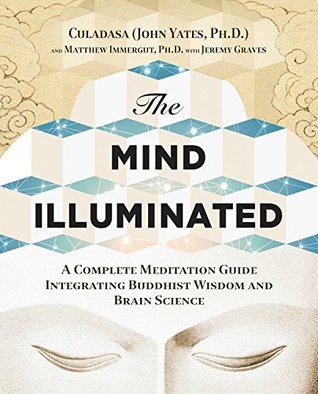More on this book
Community
Kindle Notes & Highlights
Read between
December 11, 2015 - April 16, 2017
Goals: Shorten the periods of mind-wandering and extend the periods of sustained attention to the meditation object.
Reinforcing spontaneous introspective awareness and learning to sustain attention on the meditation object.
Mastery: You can sustain attention on the meditation object for minutes, while most periods of mind-wandering last only a few seconds.
Goals: Overcome forgetting and falling asleep.
Mastery: Rarely forgetting the breath or falling asleep.
Goal: Overcome gross distraction and strong dullness.
Developing continuous introspective awareness allows you to make corrections before subtle distractions become gross distractions, and before subtle dullness becomes strong dullness.
Mastery: Gross distractions no longer push the breath into the background, and breath sensations don’t fade or become distorted due to strong dullness.
Goal: To overcome subtle dullness and increase the power of mindfulness.
Cultivating even stronger and more continuous introspective awareness to detect and correct for subtle dullness.
Mastery: You can sustain or even increase the power of your mindfulness during each meditation session.
Goal: To subdue subtle distractions and develop metacognitive introspective
Developing a much more refined and selective awareness of the mind itself, called metacognitive introspective awareness.
Mastery: Subtle distractions have almost entirely disappeared, and you have unwavering exclusive attention together with vivid mindfulness.
Goal: Effortlessly sustained exclusive attention and powerful mindfulness.
Mastery: You can drop all effort, and the mind still maintains an unprecedented degree of stability and clarity.
Goal: Complete pacification of the senses and the full arising of meditative joy
Mastery: When the eyes perceive only an inner light, the ears perceive only an inner sound, the body is suffused with a sense of pleasure and comfort, and your mental state is one of intense joy. With this mental and physical pliancy, you can sit for hours without dullness, distraction, or physical discomfort.
Goal: The maturation of meditative joy, producing tranquility and equanimity.
Mastery: Consistently evoking mental and physical pliancy, accompanied by profound tranquility and equanimity.
All you’re really “doing” in meditation is forming and holding specific conscious intentions—nothing more.
In reality, all we’re “doing” in meditation is forming and holding specific conscious intentions—nothing more. In fact, while it may not be obvious, all our achievements originate from intentions.
intentions lead to mental actions, and repeated mental actions become mental habits.
Stage One
Stage Two
Stage Three
Stages Four through Six
Stage Seven
Stages Eight through Ten
this chapter, I introduce a basic, conceptual model of Conscious Experience. You can consider this a map of the topography—the landscape of the mind, so to speak.
Each map builds on the previous ones, and together they lead you toward the two major objectives of meditation practice: stable attention and mindfulness, both of which we will look at more closely in this Interlude.
Consciousness1 consists of whatever we’re experiencing in the moment.
Attention and Peripheral Awareness Conscious experience takes two different forms, attention and peripheral awareness. Whenever we focus our attention on something, it dominates our conscious experience. At the same time, however, we can be more generally aware of things in the background.
It’s important to realize attention and peripheral awareness are two different ways of “knowing” the
You work with attention and peripheral awareness to cultivate stable attention and mindfulness—the two main objectives of meditation.
In meditation, we work with both attention and peripheral awareness to cultivate stable attention and mindfulness, the two main practice objectives of meditation.
The First Objective of Meditation: Stable Attention
Stable attention is the ability to direct and sustain the focus of attention, and control the scope of attention.
Stable attention is the ability to intentionally direct and sustain the focus of attention, as well as to control the scope of attention
Intentionally directing and sustaining attention simply means that we learn to choose which object we’re going to attend to, and keep our attention continuously fixed on it.
Controlling the scope of attention means training the mind to adjust how wide or narrow our focus is, and being more selective and intention...
This highlight has been truncated due to consecutive passage length restrictions.
Spontaneous Movements of Attention To develop intentionally directed, stable attention, you must first have a clear understanding of its opposite, spontaneous movements of attention. Attention moves spontaneously in three different ways: scanning, getting captured, and alternating.
Scanning
Getting captured
Scanning is when your focus moves from object to object, searching for something of interest.
captured
alternating attention
During meditation, intentional movements of attention will eventually replace all three types of spontaneous movements of attention.
Intentionally directed attention4 means just that: we make a conscious decision about what to pay attention to.
Intentionally directed and sustained attention means spontaneous movements of attention stop.


